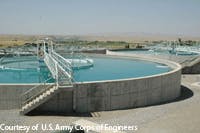The Erbil-Ifraz Water Treatment Plant, one of the three largest infrastructure projects in Iraq, is complete and now being operated by the Kurdish Regional Government.
On July 20, 2006, the U.S. Army Corps of Engineers and the governor of Erbil signed documents entrusting the water treatment plant over to the KRG for both use and maintenance. Currently, the facility distributes 4,000 cubic meters per hour providing water to a population of 975,000.
The opportunity for future expansion was included in the design of the plant. Erbil’s Ministry of Electricity is building a new power-line substation to support additional pumps, thus providing more water to Erbil and its outer lying villages. The facility’s ultimate design capacity is 10,000 cubic meters per hour. The 31 kilometer pipeline built to deliver this water was sized to accommodate the increase and expansion.
Located on the Great Zab River, water is drawn into the treatment plant and then transferred by the Ifraz High lift Pump station to Maroda booster station. Next, Maroda pushes the water to the Dawajin 20,000 cubic meter storage reservoir. The water from the Dawajin reservor then moves by gravity to the 800 mm and 500 mm main distribution lines serving the city of Erbil.
The city is currently experiencing difficulties with the water network supporting the new influx of water. Leaks are springing up all over the city due to the increased water pressure. To contain the problem, Erbil’s Director of Water, Masoud Karrash, divided the city into 54 sectors to make pinpointing the problems in the network much easier.
Karrash says the leaks are a welcome problem, “This means the city is receiving the much longed for water.”
The collateral benefits of the water plant other than more potable water availability are increased water pressure, which reduces contamination, filling of the existing water storage tanks and slowing aquifer depletion.
“This project will change the landscape of Erbil for generations to come,” said Gary York, the U.S. Army Corps of Engineers resident engineer. “The benefits of this plant are beyond measure.”
The contractor who built this $191 million project also trained the 78 local operating staff members that will run the facility on a day- to-day basis. Classes and hands-on training were conducted on site. The U.S. Army Corps of Engineers’ role in this design built contract went beyond Quality Assurance and Contract Administration. The Corps coordinated with the Ministry of Water and was instrumental in the commissioning and testing of the equipment.
Using state of the art equipment, this facility is equal to those in the U.S. and meets U.S. and British standards. Completion of this plant will have an impact not only on Erbil but the whole region, which has suffered from a shortage of water for over 20 years. The growth potential for Erbil is unlimited as long as there is a clean reliable source of water serving the community.
Source: U.S. Army Corps of Engineers


